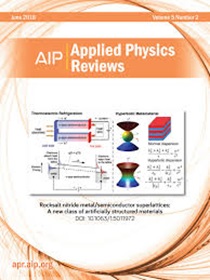Multisensory integration neuromorphic device based on ferroelectric polar order change in atomic-thick α-In2Se3
IF 11.6
1区 物理与天体物理
Q1 PHYSICS, APPLIED
引用次数: 0
Abstract
A multimodal nociceptor is an essential sensory receptor and can rapidly generate pain signals to make the body avoid potential damage from a variety of different noxious stimuli. Realizing multimodal neuromorphic behaviors in an electronic device is crucial for the development of artificial intelligence yet remains poorly explored. In this study, we propose and experimentally demonstrate an electronic multimodal nociceptor based on the monolayer atomic-thick van der Waals (vdW) α-In2Se3 ferroelectric. The demonstrated device is a semitransparent and flexible two-terminal planar architecture. Under voltage or white light stimuli, the devices all exhibit specific nociceptive characteristics including the “threshold,” “no adaptation,” “relaxation,” “allodynia,” and “hyperalgesia.” When voltage and light are co-stimulated, the device shows a smaller threshold level. Such nociceptive behaviors are attributed to electric or light-triggered ferroelectric polar ordering change. This work bestows two-dimensional vdW ferroelectric materials with a new functional application of the artificial multimodal nociceptors, and also suggests their outstanding potential for the development of artificial intelligence systems, such as biomimetic robots.基于α-In2Se3原子厚度铁电极性顺序变化的多感觉整合神经形态装置
多模态伤害感受器是一种重要的感觉受体,可以快速产生疼痛信号,使身体避免各种不同的有害刺激的潜在伤害。在电子设备中实现多模态神经形态行为对人工智能的发展至关重要,但尚未得到充分的探索。在这项研究中,我们提出并实验证明了一种基于单层原子厚范德华(vdW) α-In2Se3铁电的电子多模态伤害感受器。所演示的器件是一种半透明、柔性的双端平面结构。在电压或白光刺激下,这些设备都表现出特定的伤害性特征,包括“阈值”、“不适应”、“放松”、“异常痛觉”和“痛觉过敏”。当电压和光共同刺激时,该装置显示出较小的阈值水平。这种伤害行为归因于电或光触发的铁电极性顺序变化。本研究为二维vdW铁电材料提供了人工多模态伤害感受器的新功能应用,并表明其在仿生机器人等人工智能系统的发展方面具有突出的潜力。
本文章由计算机程序翻译,如有差异,请以英文原文为准。
求助全文
约1分钟内获得全文
求助全文
来源期刊

Applied physics reviews
PHYSICS, APPLIED-
CiteScore
22.50
自引率
2.00%
发文量
113
审稿时长
2 months
期刊介绍:
Applied Physics Reviews (APR) is a journal featuring articles on critical topics in experimental or theoretical research in applied physics and applications of physics to other scientific and engineering branches. The publication includes two main types of articles:
Original Research: These articles report on high-quality, novel research studies that are of significant interest to the applied physics community.
Reviews: Review articles in APR can either be authoritative and comprehensive assessments of established areas of applied physics or short, timely reviews of recent advances in established fields or emerging areas of applied physics.
 求助内容:
求助内容: 应助结果提醒方式:
应助结果提醒方式:


